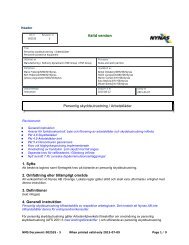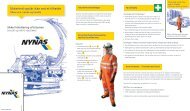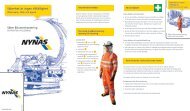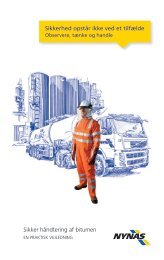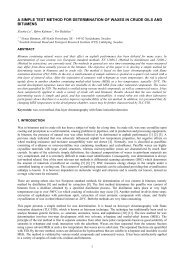Achieve better roads in Poland while saving resources with ... - Nynas
Achieve better roads in Poland while saving resources with ... - Nynas
Achieve better roads in Poland while saving resources with ... - Nynas
Create successful ePaper yourself
Turn your PDF publications into a flip-book with our unique Google optimized e-Paper software.
<strong>Achieve</strong> <strong>better</strong> <strong>roads</strong> <strong>in</strong> <strong>Poland</strong> <strong>while</strong> sav<strong>in</strong>g <strong>resources</strong><br />
<strong>with</strong> French function dissociation concept<br />
Yves Brosseaud - Laboratoire Central des Ponts et Chaussées (France)<br />
Bogdan Bogdanski - Roads Laboratory of GDDKiA Poznan (<strong>Poland</strong>)<br />
Didier Carré - Product Manager - <strong>Nynas</strong> Bitumen (France)<br />
Summary<br />
The efficient allocation of <strong>resources</strong> is the key for durable development <strong>in</strong> general and <strong>in</strong><br />
particular <strong>in</strong> Road Construction. Experience has demonstrated that a technology embrac<strong>in</strong>g<br />
too much function is wast<strong>in</strong>g valuable <strong>resources</strong>. Skid resistance and structural strength<br />
have to be optimised <strong>in</strong>dependently to reduce the construction and ma<strong>in</strong>tenance expenses.<br />
Th<strong>in</strong> Surfac<strong>in</strong>g technology (Béton Bitum<strong>in</strong>eux Très M<strong>in</strong>ces) is reduc<strong>in</strong>g the need for high<br />
PSV required for long last<strong>in</strong>g skid resistance whereas High Modulus Hot Mixes (Enrobé à<br />
Module Elevé) are allow<strong>in</strong>g construction of th<strong>in</strong>ner pavements.<br />
In order to help <strong>Poland</strong> to respond to the <strong>in</strong>crease of volume and severity of road traffic<br />
happen<strong>in</strong>g <strong>with</strong> the enlargement of European Union, a technical and <strong>in</strong>stitutional cooperation<br />
– COCOP - has been organised. This jo<strong>in</strong>t project <strong>in</strong>volves the French Road<br />
Direction, the Polish Public Road Direction and the Polish Highway build<strong>in</strong>g and<br />
management Agency.<br />
The Roads Laboratory of GDDKiA Poznan and the French Road and Bridge Central<br />
Laboratory (Laboratoire Central des Ponts et Chaussées) have experimented <strong>in</strong> real scale<br />
the Function dissociation concept to a road overlay near Poznan.<br />
In co-operation <strong>with</strong> Strada and <strong>Nynas</strong> Spzoo, this project has consisted <strong>in</strong> the jo<strong>in</strong>t<br />
formulation of a Th<strong>in</strong> Surfac<strong>in</strong>g and High Modulus Hot Mix, the design of the overlay and the<br />
construction by PRID Nowy Tomysl of the overlay dur<strong>in</strong>g August and September 2002.<br />
This paper is describ<strong>in</strong>g the co-operation process dur<strong>in</strong>g this project and is giv<strong>in</strong>g<br />
recommendations and perspectives for the optimisation of <strong>resources</strong> <strong>in</strong> the ma<strong>in</strong>tenance of<br />
Polish road network.
<strong>Achieve</strong> <strong>better</strong> <strong>roads</strong> <strong>in</strong> <strong>Poland</strong> <strong>while</strong> sav<strong>in</strong>g <strong>resources</strong><br />
<strong>with</strong> French function dissociation concept<br />
Yves Brosseaud - Laboratoire Central des Ponts et Chaussées (France)<br />
Bogdan Bogdanski - Roads Laboratory of Poznan (<strong>Poland</strong>)<br />
Didier Carré - Product Manager - <strong>Nynas</strong> Bitumen (France)<br />
1. Polish and Franch co-operation for safer and longer last<strong>in</strong>g <strong>roads</strong><br />
The efficient allocation of <strong>resources</strong> is the key for durable development <strong>in</strong> general and <strong>in</strong><br />
particular <strong>in</strong> Road Construction. Experience has demonstrated that a technology embrac<strong>in</strong>g<br />
too much function is wast<strong>in</strong>g valuable <strong>resources</strong>. Skid resistance and structural strength<br />
have to be optimised <strong>in</strong>dependently to reduce the construction and ma<strong>in</strong>tenance expenses.<br />
Th<strong>in</strong> Surfac<strong>in</strong>g technology (Béton Bitum<strong>in</strong>eux Très M<strong>in</strong>ces) is reduc<strong>in</strong>g the need for high<br />
PSV required for long last<strong>in</strong>g skid resistance whereas High Modulus Hot Mixes (Enrobé à<br />
Module Elevé) are allow<strong>in</strong>g construction of th<strong>in</strong>ner pavements.<br />
In order to help <strong>Poland</strong> to respond to the <strong>in</strong>crease of volume and severity of road traffic<br />
happen<strong>in</strong>g <strong>with</strong> the enlargement of European Union, a technical and <strong>in</strong>stitutional cooperation<br />
– COCOP - has been organised. The theme of this jo<strong>in</strong>t project <strong>in</strong>volv<strong>in</strong>g the<br />
French Road Direction, the Polish Public Road Direction and the Polish Highway build<strong>in</strong>g<br />
and management Agency is the formulation of hotmix to reduce rutt<strong>in</strong>g.<br />
The Roads Laboratory of GDDKiA Poznan and the French Road and Bridge Central<br />
Laboratory (Laboratoire Central des Ponts et Chaussées) have experimented <strong>in</strong> real scale<br />
the Function dissociation concept to a road overlay near Poznan. The LCPC has participated<br />
to the selection of components, the mix design, the production, lay<strong>in</strong>g and control of an<br />
experimental overlay of a structurally damaged road near Poznan – RN 2 <strong>in</strong> August and<br />
September 2002 as well to a sem<strong>in</strong>ar present<strong>in</strong>g the results of this co-operation.<br />
Strada and <strong>Nynas</strong> Spzoo have co-operated to this project <strong>in</strong> the selection and supply ot the<br />
b<strong>in</strong>ders used respectively <strong>in</strong> the Th<strong>in</strong> Surfac<strong>in</strong>g (Béton Bitum<strong>in</strong>eux Très M<strong>in</strong>ce here after<br />
BBTM) and High Modulus Hot Mix (Enrobé à Module Elevé her after EME). These two mixes<br />
have been designed to give good surface characteristics for <strong>better</strong> safety and good fatigue<br />
and rutt<strong>in</strong>g resistance to reduce ma<strong>in</strong>tenance cost <strong>while</strong> preserv<strong>in</strong>g material <strong>resources</strong>.<br />
This paper is describ<strong>in</strong>g the co-operation process dur<strong>in</strong>g this project and is giv<strong>in</strong>g<br />
recommendations and perspectives for the optimisation of <strong>resources</strong> <strong>in</strong> the ma<strong>in</strong>tenance of<br />
Polish road network.<br />
2. Adapt<strong>in</strong>g BBTM and EME technologies to the Polish context<br />
Property Voids PCG Duriez Modulus Fatigue Rutt<strong>in</strong>g<br />
Unit [%] [voids %] [r/R <strong>in</strong> %] [MPa] [ε6 <strong>in</strong> µstra<strong>in</strong>] [%]<br />
BBTM 1 9 à 16% 10 à 18* > 0,80 Nil<br />
Nil < 15 **<br />
EME 2 à 6% < 6 * > 0,75 >14000 > 130 < 7,5 ***<br />
GB 4 5 à 8% < 9 * > 0,70 > 11000 > 100 < 10 ***<br />
*void content measured after a given number of gyrations: 25 for the BBTM, 100 or 120 for EME or GB<br />
respectively for larger stone size 14 or 20 mm.<br />
** evaluation of mechanical stability <strong>with</strong> a rutt<strong>in</strong>g test on 50 mm thick slabs submitted to 1000 cycles<br />
at ambient temperature and 3000 @ 60 °C.<br />
*** rut depth after 30000 cycles, @ 60 °C on 100 mm thickness slabs.<br />
Table 1: extract standard properties BBTM 1, EME 2, base course mix GB 4 (Grave Bitume)
The objective of this project was to adapt to the Polish conditions:<br />
• a re<strong>in</strong>forcement b<strong>in</strong>der layer hotmix close to the EME type 2 French standard [1] <strong>with</strong> high<br />
compacity and a sufficient low temperature behaviour b<strong>in</strong>der<br />
• a high and long last<strong>in</strong>g skid resistant th<strong>in</strong> surfac<strong>in</strong>g hot mix <strong>with</strong><strong>in</strong> the BBTM type 1 French<br />
standard [2] which will be compared to a SMA.<br />
The standards mechanical properties of materials used <strong>in</strong> this project are summarised <strong>in</strong><br />
Table 1.<br />
3. B<strong>in</strong>der course mix design – EME<br />
3.1. Objectives and design pr<strong>in</strong>ciples<br />
In order to take <strong>in</strong> account the Polish context, a 20/30 b<strong>in</strong>der has been chosen <strong>in</strong>stead of the<br />
10/20 typically used <strong>in</strong> France, which may be too hard regard<strong>in</strong>g the more severe w<strong>in</strong>ter<br />
conditions of Polish climate. The mix design targets are as follows:<br />
• a stiffness modulus at the m<strong>in</strong>imum of the EME 2 standard (i.e. 14000 MPa) ;<br />
• a lower fatigue resistance than for EME 2 (e.g. an admissible stra<strong>in</strong> for 10 6 cycles of<br />
110 µstra<strong>in</strong> <strong>in</strong>stead of > 130 for EME 2) ;<br />
• a rutt<strong>in</strong>g resistance of 5 % <strong>better</strong> than EME 2 standard (< 7.5 %) ;<br />
• a b<strong>in</strong>der thickness equivalent to the EME 2 (Richness modulus 1 K > 3.4)<br />
This mix design targets are a balance between the EME 2 and GB 4 standard (see Table 1<br />
and [3]) <strong>with</strong> a larger Richness Modulus (K > 2.9 for a GB 4) to achieve a lower void content<br />
(close to 5 to 6 %). This allows the use of a surface course mix <strong>with</strong> relatively high void<br />
content as a BBTM. This not possible <strong>with</strong> the traditional GB which have a void content of 9<br />
to 10 %.<br />
For the pavement design, the correction factor Kc is set to 1.3 as for the GB <strong>in</strong>stead of the 1<br />
of the EME.<br />
3.2. Components selection<br />
3.2.1. Aggregates<br />
The sands and aggregates are supplied from the same quarry: Wilkow. The b<strong>in</strong>der content<br />
had to be <strong>in</strong>creased further their very high specific gravity (close to 3.0 g/cm³). Fully crushed<br />
sands and aggregates, they have a good angularity and flak<strong>in</strong>ess. All fractions have<br />
presented a consistent grad<strong>in</strong>g <strong>with</strong> exception of the sand delivered for the job <strong>with</strong> a filler<br />
content measured at 19 % whereas 13 % was found on the lab samples. The polish stone<br />
value (PSV) of 48 is also good.<br />
Accord<strong>in</strong>g to the French standard NF P 18-540, the aggregates are of “B III a” class, which is<br />
required for BBTM, laid under heavy and high-speed traffic. This material can be used also<br />
for the EME for which the required class is only “D III a” class.<br />
3.2.2. B<strong>in</strong>der – <strong>Nynas</strong> 20/30 EME<br />
<strong>Nynas</strong> Spzoo has supplied the <strong>Nynas</strong> 20/30 EME specially designed for this project on the<br />
base of the 20/30 class of EN 12591 standard (requirement values <strong>in</strong> bracket) :<br />
• Penetration @ 25 °C: 25.3 1/10 mm [20-30]<br />
1 Richness modulus K is related to the b<strong>in</strong>der thickness:<br />
K = B<strong>in</strong>der content * (MVRg / 2,65) * (1/ (Σ) 1/5 )<br />
100*Σ = 0,25 G +2,3 S + 12 s + 135 f<br />
<strong>with</strong> : B<strong>in</strong>der content <strong>in</strong> ppc<br />
MVRg: specific gravity of the aggregates<br />
100*Σ = 0,25 G +2,3 S + 12 s + 135 f<br />
Weight proportions: G larger than 6.3 mm; S between 6.3 and 0.315mm; s between 0.315 and 0.08mm, f smaller<br />
than 0.08 mm.
• R&B: 57.6°C [55-63]<br />
• RTFOT age<strong>in</strong>g<br />
• Residual penetration : 72 % [> 55%]<br />
• R&B 63.4 °C [>57]<br />
• Delta R&B 5.8 °C [
3.8. Conclusion<br />
This 0/16 re<strong>in</strong>forcement hot mix fits <strong>with</strong> a GB 4 well adapted to the Polish context <strong>with</strong> a<br />
good durability given by a high b<strong>in</strong>der content of well-balanced penetration b<strong>in</strong>der and a low<br />
void content.<br />
3.9. Polish specification project<br />
The Polish Road and Bridge Institute (no 63) have proposed a project of recommendations<br />
for high modulus hot mixes. Accord<strong>in</strong>g to the French experience, the follow<strong>in</strong>g observations<br />
can be made regard<strong>in</strong>g their mechanical requirements on the mix:<br />
• If two types of EME have been standardised <strong>in</strong> France, only the EME 2 is used for its<br />
structural impact <strong>in</strong> re<strong>in</strong>forcement. The EME 1 is redundant <strong>with</strong> a conventional base<br />
course hot mix <strong>with</strong> <strong>in</strong>creased rutt<strong>in</strong>g resistance. To avoid confusion, the<br />
standardisation of only one EME is recommended for <strong>Poland</strong> ;<br />
• Creep modulus: the LCPC rutt<strong>in</strong>g is used <strong>in</strong> France where there is not enough<br />
experience <strong>with</strong> this creep modulus test ;<br />
• The modulus is measured @ 10 °C and 10 Hz <strong>in</strong>stead 15 °C and 10 Hz <strong>in</strong> the French<br />
standard ; this will lead to a decrease of modulus ;<br />
• The 4-po<strong>in</strong>ts bend<strong>in</strong>g fatigue @ 10 °C and 10 Hz test cannot be correlated to the 2po<strong>in</strong>ts<br />
bend<strong>in</strong>g LCPC fatigue @ 10 °C and 25 Hz test.<br />
The French mechanical requirements are result<strong>in</strong>g from the comparative laboratory and real<br />
scale experiment between the mechanical test method and measures on LCPC fatigue<br />
carousel. In <strong>Poland</strong>, the requirements have to be validated accord<strong>in</strong>g to the road design<br />
parameter (test and design temperatures) and to correlation between laboratory and real<br />
scale experience.<br />
4. Surface course – BBTM<br />
4.1. Objective and design pr<strong>in</strong>ciples<br />
As the BBTM 2 can present a too high void content for the Polish weather conditions, a<br />
BBTM 0/11 of type 1 has been formulated <strong>with</strong> a Polymer modified Bitumen Colflex N<br />
supplied by Strada.<br />
4.2. Components selection<br />
4.2.1. Aggegates<br />
The aggregates and sand are of the same orig<strong>in</strong> as for the EME (see 3.2.1).<br />
4.2.2. B<strong>in</strong>der – Colas Colflex N<br />
The Colflex N is a PmB of 50/70 penetration class SBS modified bitumen and was comply<strong>in</strong>g<br />
<strong>with</strong> the sales specifications of Strada :<br />
• Penetration @ 25 °C : 49.8 1/10 mm<br />
• R&B temperature : 53.8°C<br />
The adhesion on 8/11 aggregates from Wilkow was excellent.<br />
4.3. Gyratory compactor<br />
Further to lack of aggregates, only one Gyratory Compactor test has been performed.<br />
Nevertheless, the result was considered sufficient as no dispersion has been observed<br />
dur<strong>in</strong>g the evaluation of the EME.<br />
As the two formulas tested behaved relatively similarly, the 5.3 ppc b<strong>in</strong>der content was<br />
preferred for a good coat<strong>in</strong>g <strong>with</strong>out excess of b<strong>in</strong>der. (see Table 2).
4.4. Water sensitivity<br />
The Duriez water sensitivity test performance of the BBTM is excellent most probably<br />
because of the very good adhesivity of the Colflex N b<strong>in</strong>der (see 4.2.2).<br />
Giratory compactor V 10 gyrations V 25 gyrations V 100 gyrations V 200 gyrations<br />
17 %<br />
13.1 %<br />
Duriez r / R = 0.89 Duriez Voids<br />
8.4 %<br />
Mechanical stability<br />
3000 cycles @ 60°C<br />
50 mm thick slab<br />
Rut depth<br />
10.8 %<br />
Nota : only one<br />
slab tested<br />
7.5 %<br />
Voids filler <strong>with</strong><br />
air and b<strong>in</strong>der<br />
20.5 %<br />
Texture before<br />
test<br />
HSV = 1.4 mm<br />
5 %<br />
Voids filled by<br />
b<strong>in</strong>der<br />
59 %<br />
Void (γ <strong>in</strong> the axis)<br />
11.5 %<br />
Table 2 Summary of test performed on the BBTM by LCPC<br />
4.5. Surface texture<br />
The mechanical stability is measured by a rutt<strong>in</strong>g test performed on a 50 mm slab after 1000<br />
cycles at ambient temperature and 3000 cycles @ 60 °C (see Table 1 and Table 2). The<br />
10 % rut depth is lower than the 15 % specification <strong>with</strong> a texture ma<strong>in</strong>ta<strong>in</strong>ed dur<strong>in</strong>g the test.<br />
Some stone loss dur<strong>in</strong>g the test can be related to the low R<strong>in</strong>g & Ball temperature of the<br />
b<strong>in</strong>der below the test temperature (see 4.2.2)<br />
4.6. Conclusion<br />
The surface course 0/11 hot mix formulated is compliant <strong>with</strong> the target: BBTM 1. The type 2<br />
would have been too open for the Polish climate but a 0/6 mm type 1 could give anyway<br />
already good noise reduction provided that particular care is given to the grad<strong>in</strong>g of the<br />
aggregates fraction and to the their shape.<br />
5. Re<strong>in</strong>forcement design <strong>with</strong> Alizé<br />
Us<strong>in</strong>g the Alizé model, based French Pavement Design method, the thickness of the overlay<br />
design criteria is, for a given risk of failure, the number of cycle before fatigue failure of the<br />
base course. The number of cycle is related to the horizontal tensile stra<strong>in</strong> at its base by the<br />
fatigue curve of the material.<br />
At a risk of failure of 10 %, 10 cm of the above design EME 0/16 is behav<strong>in</strong>g like a GB 4 <strong>with</strong><br />
3 cm of the BBTM 0/11 will have a 13.4 years life expectancy <strong>with</strong> 25.5 millions of 100 kN<br />
equivalent trucks. With the same hypothesis, the Polish base design (8 cm b<strong>in</strong>der course<br />
0/31) will have a life expectancy of only 4.5 years.<br />
Accord<strong>in</strong>g to the French hypothesis, the estimation of the frost protection of this structure is<br />
giv<strong>in</strong>g a frost <strong>in</strong>dex of only 190 °C. This value may be considered as low as correspond<strong>in</strong>g to<br />
the frost <strong>in</strong>dex of Strasbourg. A check of this structure accord<strong>in</strong>g to the Polish frost design<br />
method is recommended.<br />
6. N 2 Job - first impressions<br />
The experimental section is located on the N2 between Belowice and Lwowek and between<br />
the km 119 450 and 120 500. This is a straight road <strong>with</strong>out cross<strong>in</strong>g <strong>with</strong> a plan profile. The<br />
transversal profile was widened to 11.50 m before the overlay.<br />
The overlay of the trial section is made of:<br />
• Local plane out of the axis and of the rut shoulders
• 12 cm of the EME 0/16 <strong>with</strong> a emulsion tack coat<br />
• 3 cm of the BBTM 0/11 en 3 cm for 500 m and of SMA for 500 m as reference for the<br />
surface properties.<br />
The reference structure is composed of 8 cm of a 0/31 base course mix <strong>with</strong> 3.5 to 4 %<br />
b<strong>in</strong>der content and 4 cm of SMA. Because of its high maximum stone size, the base course<br />
shows a very open and heterogeneous aspect.<br />
PRID Nowy Tomysl has laid the EME and BBTM respectively between the 28/08 and<br />
04/09/2002 and from the 09 to 11/09/2002 under satisfactory weather conditions.<br />
If the job has been carried accord<strong>in</strong>g to the recommendations of the LCPC, the follow<strong>in</strong>g<br />
po<strong>in</strong>ts can be improved:<br />
• Regularity of aggregate production: they have presented too high grad<strong>in</strong>g variation (filler<br />
content between 12 to 20 % <strong>in</strong> the sand where only 3 % is tolerated <strong>in</strong> France). The<br />
formulation had to be recomposed <strong>in</strong> the mix<strong>in</strong>g plant <strong>with</strong> <strong>in</strong>evitable variations on the mix<br />
formula particularly for the BBTM.<br />
• Tune up of the mix<strong>in</strong>g plant: several adaptations of the parameters where required further<br />
to the results of the hotmix quality control (this new mix<strong>in</strong>g plant was <strong>in</strong>deed produc<strong>in</strong>g its<br />
first tons of hotmix).<br />
• Tune up of the paver: a test strip laid before the job would have allow a <strong>better</strong> lay<strong>in</strong>g and<br />
avoid the evenness problem. The low quantities of material to lay (3500 t of EME and<br />
420 t of BBTM) have complicated the job. Anyway, the low speed of the job limited by the<br />
low throughput of mix<strong>in</strong>g plant (90 t/h) has made possible a very good compaction.<br />
• Stops of the mix<strong>in</strong>g plant due to failures of the sand alimentation from to the abovementioned<br />
excess of filler. They have caused stops of the pav<strong>in</strong>g <strong>with</strong> the consequence<br />
of other evenness problems.<br />
The above problems dur<strong>in</strong>g the first application of a new technology <strong>with</strong> a new referential<br />
are common. A period of practice is often required to take <strong>in</strong> account all the new parameters<br />
and difficulties.<br />
Thanks to the commitment of the crew, despite these <strong>in</strong>cidents, the job has been carried <strong>in</strong><br />
relatively good conditions, which let us all hope that a representative behaviour of an<br />
EME/BBTM structure can be followed up. These fluctuations should be anyway taken <strong>in</strong><br />
consideration <strong>while</strong> draw<strong>in</strong>g conclusions of this road trial.<br />
7. Conclusion<br />
This co-operation between the Polish and the French road authorities has confirmed that<br />
material, laboratory equipment and method are available to improve the functional<br />
performance of hotmixes <strong>in</strong> <strong>Poland</strong>.<br />
This job is the first opportunity to adjust<br />
• for EME 2: the fatigue criteria and frost protection accord<strong>in</strong>g to the Polish overlay<br />
strategy ;<br />
• for BBTM 1 (<strong>with</strong> sand patch between 0.8 and 1 mm) <strong>in</strong> comparison <strong>with</strong> the SMA: the<br />
behaviour under w<strong>in</strong>ter condition of the high rugosity required for long last<strong>in</strong>g skid<br />
resistance.<br />
A follow up over at least 5 years is required to compare the behaviour of EME + BBTM<br />
solution versus the conventional design. The ma<strong>in</strong> parameters to control are the surface<br />
characteristics (macro texture and skid resistance) and the mechanical resistance (aga<strong>in</strong>st<br />
rutt<strong>in</strong>g and fatigue crack<strong>in</strong>g) as well as behaviour under low temperature climate.
Fac<strong>in</strong>g <strong>in</strong>creased traffic agressivity, it seems that the suggested solution can be developed<br />
on the Polish ma<strong>in</strong> road network:<br />
• <strong>with</strong><strong>in</strong> modernisation projects and structural re<strong>in</strong>forcement,<br />
• whilst improv<strong>in</strong>g the safety for road users <strong>with</strong> <strong>better</strong> surface properties (no rutt<strong>in</strong>g,<br />
texture, evenness).<br />
8. Bibliography<br />
1. French standard XP P98-137 - Enrobés hydrocarbonés - Couches de roulement : bétons<br />
bitum<strong>in</strong>eux très m<strong>in</strong>ces - Déf<strong>in</strong>ition - Classification - Caractéristiques - Fabrication - Mise<br />
en œuvre (05/2001)<br />
2. French standard NF P98-140 - Enrobés hydrocarbonés - Couches d’assises : enrobés à<br />
module élevé (EME) - Déf<strong>in</strong>ition - Classification - Caractéristiques - Fabrication - Mise en<br />
œuvre (11/1999)<br />
3. French standard NF P98-138 Enrobés hydrocarbonés - Couches d'assises : gravesbitume<br />
(GB) - Déf<strong>in</strong>ition - Classification - Caractéristiques - Fabrication - Mise en oeuvre<br />
(11/1999)<br />
4. Very th<strong>in</strong> and ultra-th<strong>in</strong> wear<strong>in</strong>g courses us<strong>in</strong>g hot-mixed bitum<strong>in</strong>ous materials - A review<br />
of use and performance, Y. Brosseaud LCPC - Nantes – France <strong>in</strong> Cedex conference,<br />
Madrid (1997)<br />
5. Compared performance of very th<strong>in</strong> wear<strong>in</strong>g courses us<strong>in</strong>g cold and hot mixed<br />
bitum<strong>in</strong>ous materials - Assessment of French experience, Y. Brosseaud LCPC - Nantes -<br />
France <strong>in</strong> 1st World conference on highway surfac<strong>in</strong>g - Budapest, Hungary (1998)<br />
6. Performance d’adhérence des revêtements sur les chaussées françaises, Y. Brosseaud<br />
LCPC - Nantes - France, G. Delalande LRPC - Angers - France <strong>in</strong> Surf 2000 (AIPCR)<br />
Nantes (2000)<br />
7. The French approach to asphalt mixture design - a performance related system of<br />
specification, JF. Corte (LCPC), JP. Serfass (SCREG) <strong>in</strong> TRB (2000)<br />
8. Development and uses of hard grade asphalt and high modulus asphalt mixes <strong>in</strong> France,<br />
JF. Corté (LCPC) <strong>in</strong> TRB (2001)<br />
9. Investigation of rutt<strong>in</strong>g of asphalt surface layer: <strong>in</strong>fluence of b<strong>in</strong>der and axle load<strong>in</strong>g<br />
configuration, JF. Corté, Y. Brosseaud, JP. Simoncelli, G. Carof (ASFA) <strong>in</strong> TRR n°1436<br />
(p 28 -37) (1994)<br />
10. Les Enrobés à Module Elevé, Note d’<strong>in</strong>formation du Setra n°96 (04/1997)<br />
11. Les Bétons Bitum<strong>in</strong>eux Très M<strong>in</strong>ces et Ultra M<strong>in</strong>ces, Note d’<strong>in</strong>formation du Setra n°94<br />
(04/1997)<br />
12. Guide d’application des normes pour le réseau routier national, SETRA LCPC (04/1994)<br />
13. Guide technique de conception et de dimensionnement des structures de chaussée,<br />
SETRA LCPC (09/1994)



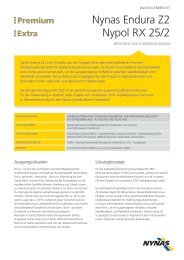
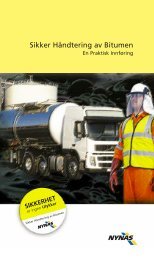

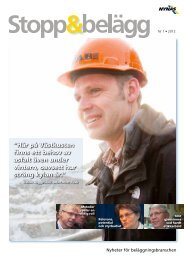
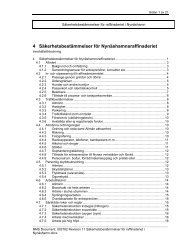
![Säkerhetsbestämmelser Gbg rev 5.ppt [Compatibility Mode] - Nynas](https://img.yumpu.com/18742268/1/190x146/sakerhetsbestammelser-gbg-rev-5ppt-compatibility-mode-nynas.jpg?quality=85)
